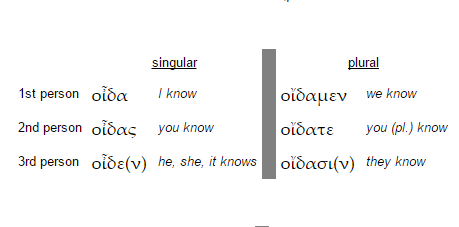
The Greek perfect tense-form is the most puzzling of the indicative forms. Its formation is interesting, its aspectual value is debated, and its flexibility in use is astounding. I’m always happy to learn more about the perfect and I hear there is an entire edited volume coming out on it. But until then, we can whet our appetite with several essays in the recently published The Greek Verb Revisited. In this volume are three essays that attack the perfect from three different topics: morphology, aspect, and discourse function.
R. Crellin examines the aspectual value of the perfect. He argues that “[T]he perfect of a predicate derives a homogeneous atelic eventuality from the predicate for a grammatical subject and includes Topic Time in the Situation Time of this derived homogenous atelic eventuality.” Sounds complicated, huh? It is, slightly, but if you buy the book and read the essay, Crellin actually explains it quite well. He continues: properties of the subject that can be considered part of this “post-state eventuality” include pure states, result states, and the situation pertaining after an event (449–450). All three are atelic and homogenous. He take on the perfect’s aspectual value highlights the “stative” quality that it often denotes and also allows much flexibility in the kind of states that can be expressed.
Steven Runge argues that the discourse function of the perfect tense-form is “to correlate logically anterior states of affairs with the current discourse situation” (458-486, quote on 482). Perfects can precede that to which they are relevant, follow that to which they are relevant, or be situated on the theme line in embedded speeches or simply on the theme line in nonnarrative contexts (with a few exceptions). Runge suggests the function of the perfect, contrary to the claims of Porter and Campbell, is not to mark prominence, but rather “to offer expositional support for a more salient element” (482). Such a claim has significant value for exegesis, if correct, since perfect verbs would be supportive rather than prominent.
R. Booth analyzes the morphological components of the prefect and notices that the kappa perfect has two fused etymologies, a perfective etymology from the kappa aorist, and a frequentive etymology connected with its reduplication (416-429). The perfect middle uses primary middle endings, which suggests an imperfective character to what are typically stative lexemes (e.g., κεῖμαι, κάθημαι, δύναμαι). The complex nature of the perfect’s semantics (as combining perfective and imperfective notions) are thus mimicked by its complex morphological features. Again this sounds complex (and is a bit), but it highlights the value of morphology, something we often curse as we memorize paradigms and features such as tense-formatives.
While these are only three essays that do not really interact with each other and that touch on three different topics, they are all useful discussions that help the reader better understand the perfect–why it is formed the way it is, what its aspectual value is, and how it functions in discourse. While none of them are the final answer, they are worth consulting and keeping in mind as you read your Greek NT and come across all those perfects, which are notoriously difficult to evaluate.
Read more about The Greek Verb Revisited or buy it on Amazon.
